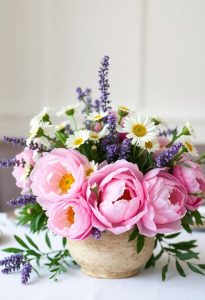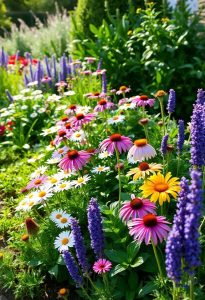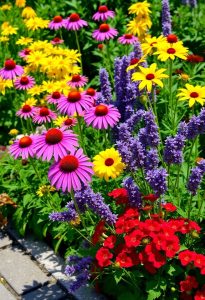Want to create a breathtaking flower bed that pops with bold colors? Start by picking a color palette that matches your surroundings. Mix tall, medium, and short flowers for depth, like spiky snapdragons next to soft petunias. Don’t forget to include seasonal bloomers for all-year color! And hey, adding colorful pots can really tie it all together. It’s like adding sprinkles on a cake! Curious about more tips to make your garden shine? You’ll definitely want to stick around!
Design Highlights
- Choose a vibrant color palette, mixing contrasting colors like purple and yellow for visual impact in your flower bed design.
- Incorporate flowers that bloom in different seasons to ensure continuous color throughout the year.
- Layer flowers by height, placing tall plants at the back and shorter ones in front for depth and dimension.
- Use colorful borders and pathways to frame flower beds, creating structure and guiding the eye through the garden.
- Regular maintenance, including watering and pruning, is essential to keep colors vibrant and flowers healthy.
Choosing the Right Color Palette
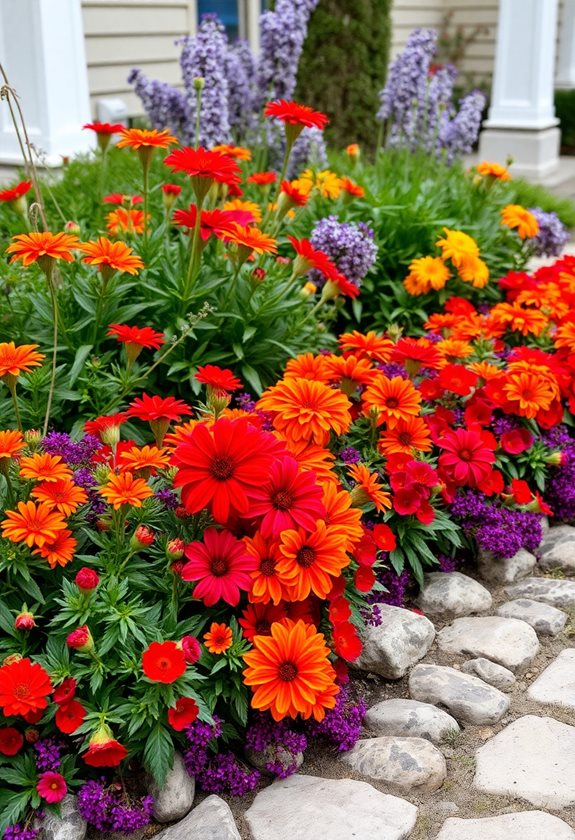
Have you ever wandered through a garden and felt a wave of emotion from the colors surrounding you? Choosing the right color palette is essential for creating that enchanting vibe. Think about your favorite hues—do they inspire joy or calm? Here are a few tips to guide you:
Wander through vibrant colors in your garden, and let your favorite hues inspire joy and calm.
- Complementary Colors: Pair opposite colors for a vibrant look.
- Analogous Colors: Stick to neighboring colors for harmony.
- Seasonal Vibes: Use warm tones for summer, cool tones for winter.
Experiment with different combinations, and don’t be afraid to add a splash of the unexpected—after all, gardening’s about expression and joy! Incorporating low-maintenance flower bed plants can also enhance the beauty while reducing your workload.
Understanding Flower Heights and Layers
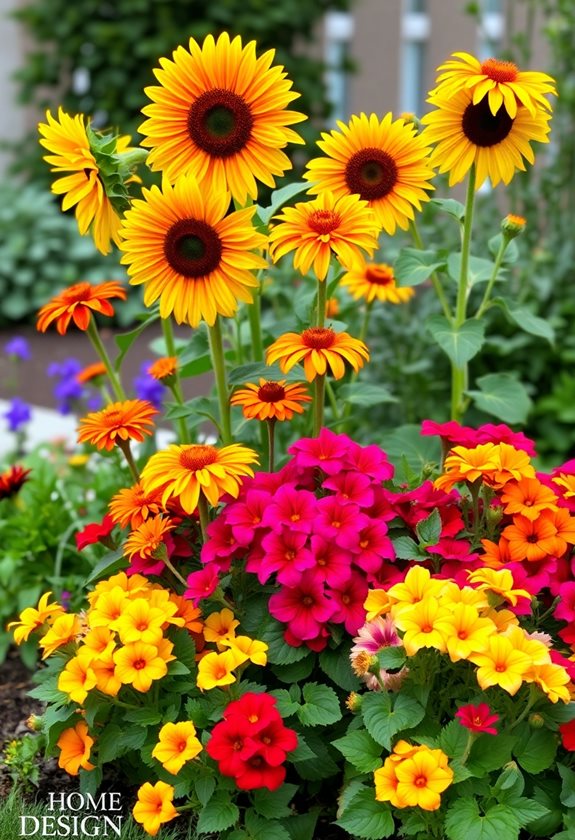
When designing a flower bed, understanding flower heights and layers can transform your garden into a stunning masterpiece! Imagine this: tall flowers like sunflowers standing proudly behind shorter blooms like marigolds. It’s all about creating depth and drama!
Here’s how you can master this:
- Tall plants (3-4 feet): Placed at the back.
- Medium plants (1-2 feet): In the middle.
- Short plants (under 1 foot): At the front.
Incorporating bold colors in your flower bed design can enhance the visual appeal and make your garden truly stand out!
Selecting Complementary and Contrasting Blooms
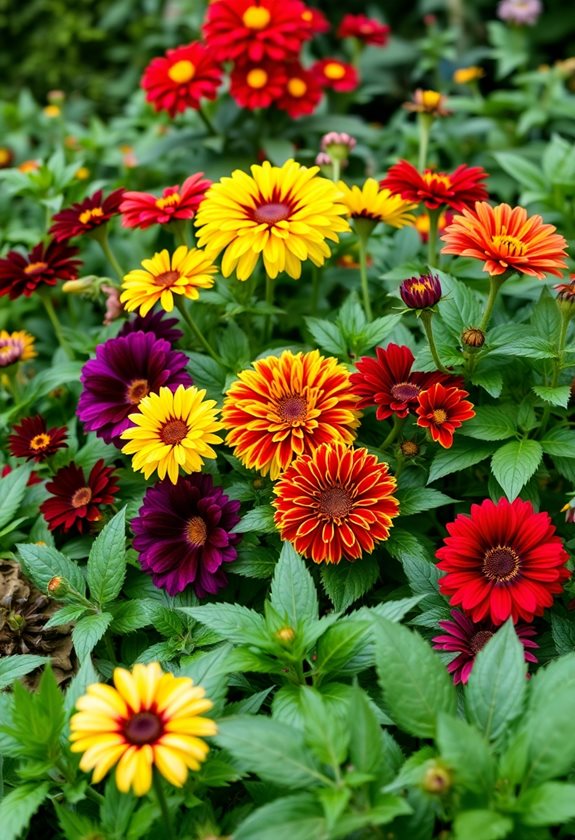
While selecting the right blooms for your flower bed, it’s essential to think about how colors and shapes can work together to create an inviting atmosphere. Consider pairing complementary colors, like purple and yellow, to make each flower pop. Want to spice things up? Mix in contrasting blooms, such as vibrant red with soft pinks, for a dynamic look! Don’t forget about shape—tall, spiky flowers can stand proudly next to round, fluffy ones. Experiment! What colors do you love? You might just discover a stunning combination that’ll make your garden the talk of the neighborhood. Incorporating colorful flower beds can greatly enhance your garden’s appeal to pollinators. Happy planting!
Seasonal Considerations for Colorful Flowers
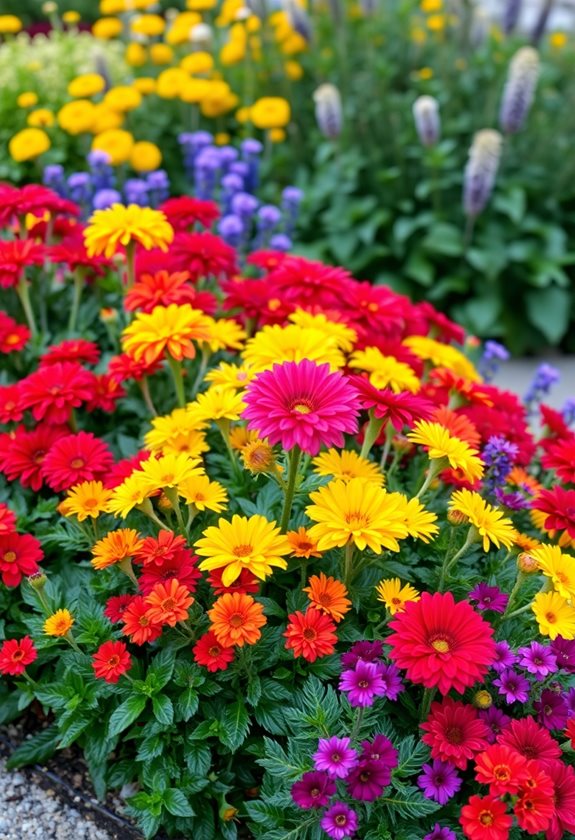
As you immerse yourself in the world of colorful flowers, understanding seasonal considerations can truly elevate your garden game! Timing’s everything, right? Spring blooms like tulips and daffodils kick off the vibrant show, while summer brings zinnias and sunflowers bursting with energy. Don’t forget fall, when asters and chrysanthemums steal the scene! Each season has its champions, so plan accordingly. Have you ever tried mixing early and late bloomers? You’ll create a stunning, extended display! Remember, seasonal shifts also influence colors—soft pastels for spring, bold hues for summer. To enhance your garden’s appeal, consider seasonal plant selection to ensure a diverse and beautiful array of flowers throughout the year. What will you choose to paint your canvas? Happy planting!
Incorporating Foliage for Visual Interest

Incorporating foliage into your garden design can be a game-changer, especially if you want to create layers of visual interest that keep your space lively all year round! Think about contrasting colors and textures—lush greens paired with vibrant flower hues can make your blooms pop! Consider using:
- Hostas for their large leaves
- Heuchera for stunning color variations
- Ferns for delicate textures
These additions invite curiosity and depth. Ever tried planting different heights? Taller foliage in the back creates a stunning backdrop! Additionally, incorporating year-round foliage can ensure your garden remains beautiful even in the off-season. So, what foliage will you choose to elevate your garden? Your plants are just waiting to shine!
Using Accessories to Enhance Your Design
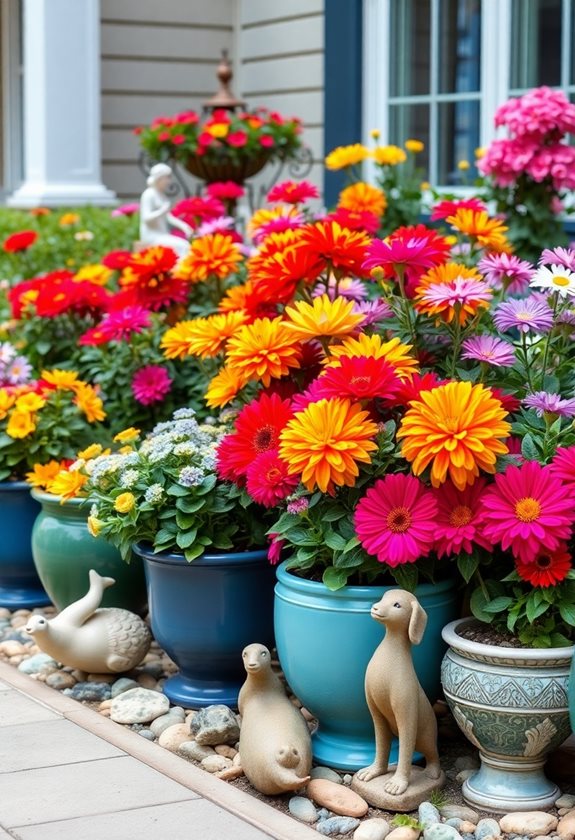
When you think about sprucing up your garden, accessories can be the secret sauce that ties everything together! Imagine adding vibrant pots, whimsical garden sculptures, or a rustic trellis to elevate your bold color flower bed. These elements not only add personality but also create focal points.
Try these tips:
- Use colorful pots that complement your blooms.
- Incorporate stepping stones for visual flow; consider using natural river rocks to enhance the aesthetic appeal.
- Add whimsical touches like fairy lights or decorative stakes.
Don’t underestimate the power of these small details! They can transform a simple garden into a stunning masterpiece. Ready to release your creativity? Let’s get accessorizing!
Planning for Year-Round Color
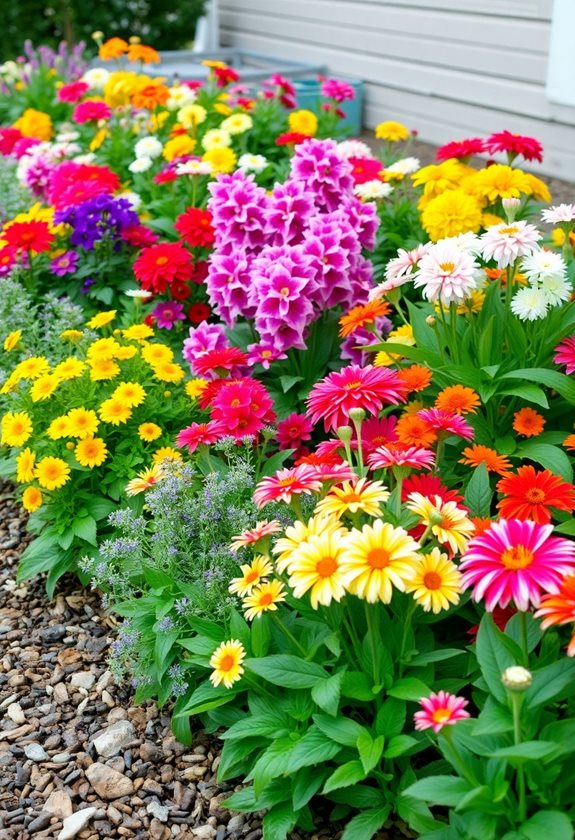
Creating a flower bed that shines all year long is like orchestrating a symphony of colors and textures, and trust me, the audience (that’s you and your friends!) will want to stick around for the show. Start by selecting plants with staggered bloom times—think early spring crocuses, summer dahlias, and fall asters. Mixing evergreens adds structure during winter, while vibrant annuals keep the display lively. Consider layering heights and textures, too! Ever thought about adding some ornamental grasses? They sway beautifully in the breeze! Additionally, incorporating beautiful flower bed ideas can elevate your landscape and provide inspiration. With these tips, you’ll create a stunning, year-round masterpiece that’ll have everyone asking for your gardening secrets!
Tips for Maintaining Your Flower Bed
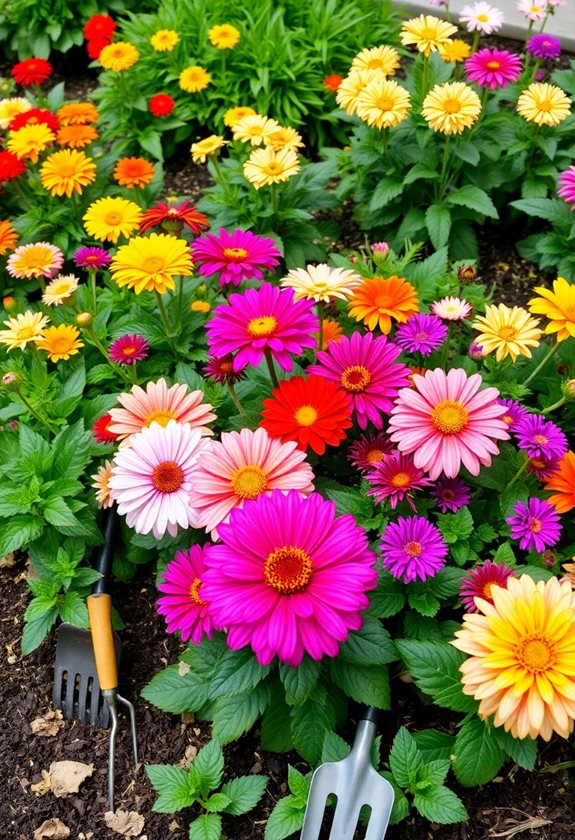
Maintaining a flower bed can feel like an ongoing adventure, especially when you realize how much joy those blooms can bring to your space! To keep your garden thriving, start with regular watering—aim for early mornings to minimize evaporation. Don’t forget to deadhead spent blooms; it encourages new growth and keeps your bed looking fresh. Mulching helps retain moisture and suppress weeds, too! And, hey, be on the lookout for pests! A simple soapy water spray can work wonders. Additionally, consider incorporating best flowering plants for even more vibrant colors and textures. So, what’s stopping you? Immerse yourself, enjoy the process, and watch your vibrant oasis flourish! Your flower bed deserves your love!
Inspiration From Professional Garden Designers
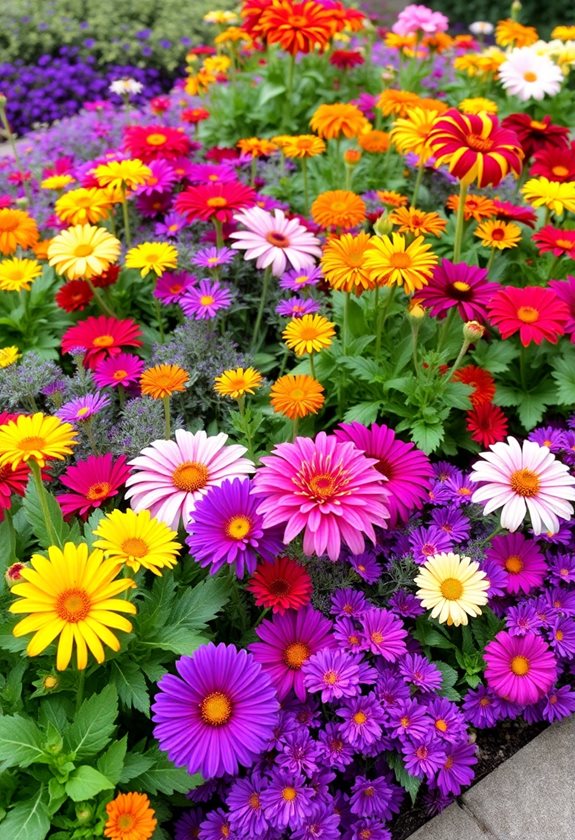
You’ve put in the hard work to maintain your flower bed, but have you ever thought about how professional garden designers approach their craft? They often blend texture and color in unexpected ways. For instance, consider pairing deep purple asters with vibrant yellow marigolds for a striking contrast.
- Use layers: Taller plants in the back, shorter in front.
- Mix shapes: Round flowers with spiky foliage adds interest.
Look for inspiration online or in garden centers. You might discover a unique combination that sparks your creativity! Remember, it’s all about experimenting and having fun. Additionally, consider incorporating colorful flower borders to frame your design and enhance the overall appeal. So, what bold design will you try next?
Frequently Asked Questions
What Flowers Are Best for Attracting Pollinators?
Imagine a garden buzzing with life, where butterflies dance and bees hum their happy tunes! To attract pollinators, you’ll want to plant flowers like lavender, coneflowers, and sunflowers—they’re irresistible! These beauties not only brighten your garden but also create a vibrant ecosystem. Don’t forget to include herbs like basil and mint; they’re pollinator magnets! Trust me, once you’ve seen them flock to your blooms, you’ll be hooked on gardening!
How Do I Avoid Color Clashes in My Garden?
To avoid color clashes in your garden, start by choosing a cohesive color palette. Think about combining complementary colors, like blue and orange or yellow and purple. You can also use a neutral background, like greens or whites, to let bold colors pop! Don’t forget to contemplate the size and shape of flowers, too—mixing tall and short plants can create a stunning visual effect. Ever tried color wheels? They’re a gardener’s best friend!
Can I Use Perennials and Annuals Together?
Absolutely, you can mix perennials and annuals! It creates a dynamic garden that blooms throughout the seasons. Think about this: annuals, like petunias, add vibrant color right away, while perennials, such as daylilies, offer lasting beauty year after year. Just make sure to take into account their sunlight and water needs. Why not try layering them? You’ll get depth and interest! Enjoy the process, and don’t forget to have fun experimenting with different combinations!
What Soil Type Is Best for Vibrant Blooms?
Imagine walking into a garden bursting with color, where every bloom seems to sing! For vibrant flowers, you need well-draining soil rich in organic matter. Think loamy soil that retains moisture yet allows excess water to escape. Mix in compost or aged manure to boost nutrients. If you’re unsure, a simple soil test can guide you. Remember, happy roots lead to happy blooms! So, what are you waiting for? Get digging!
How Do I Choose Flowers for a Shady Area?
Choosing flowers for a shady area can be tricky, but you’ve got this! Start by looking for shade-tolerant varieties like hostas, ferns, or astilbes. Consider the amount of shade—light, partial, or full—and pick flowers that thrive in that environment. Mix textures and colors for a vibrant look! Got any favorites? And remember, even in the shade, your garden can shine! Let’s turn that dull spot into a stunning oasis!


